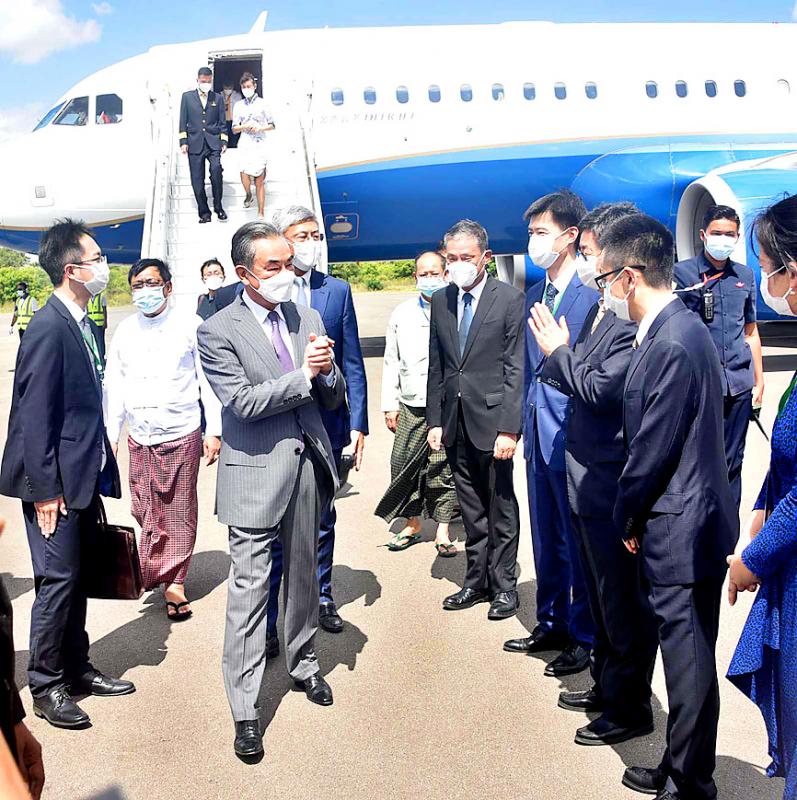China’s top diplomat on Saturday arrived on his first visit to Myanmar since the military seized power last year to attend a regional meeting that the Burmese government said was a recognition of its legitimacy and opponents protested as a violation of peace efforts.
Chinese Minister of Foreign Affairs Wang Yi (王毅) is to join counterparts from Myanmar, Laos, Thailand, Cambodia and Vietnam in a meeting of the Lancang-Mekong Cooperation group in the central city of Bagan, a UNESCO World Heritage site.
The grouping is a Chinese-led initiative that includes the countries of the Mekong Delta, a potential source of regional tensions due to an increasing number of hydroelectric projects that are altering the water flows and raising concerns of ecological damage.

Photo: EPA-EFE
China has built 10 dams along the upper stretch of the Mekong River, the part it calls the Langcang River.
Burmese Deputy Minister of Information Major General Zaw Min Tun told a news conference in the capital, Naypyidaw, on Friday that the attendance of the foreign ministers at the meeting was a recognition of Myanmar’s sovereignty and its government.
The ministers are to sign memorandums of understanding and contracts, he said without elaborating.
It is unclear whether Wang would meet Burmese Army Senior General Min Aung Hlaing, the head of the military government.
Myanmar’s military seized power from the elected government of Aung San Suu Kyi on Feb. 1 last year. It was quickly met by nonviolent nationwide demonstrations and triggered armed resistance that some UN experts now characterize as civil war.
According to a detailed list compiled by the Assistance Association for Political Prisoners, 2,053 civilians have died in the crackdown on the resistance movement.
Wang last visited Myanmar to meet with Suu Kyi just three weeks before the military ousted her.
China is Myanmar’s largest trading partner and an long-time ally. Beijing has invested billions of dollars in Myanmar’s mines, oil and gas pipelines, and other infrastructure, and is its major arms supplier.
Many in Myanmar suspect China of supporting the military takeover, and Beijing has refused to condemn the army’s power grab. China says it follows a policy of noninterference in other countries’ affairs.
The minister of foreign affairs in Myanmar’s shadow government, which opposes the ruling military council, protested the Bagan meeting, saying that such efforts in partnership with Myanmar’s military violate the will of the people and undermine community building.
The statement said that holding the foreign ministers’ meeting in Myanmar is in direct opposition to an ASEAN peace plan.
Myanmar, although a member of ASEAN, has done little to implement the plan, and its stonewalling led fellow ASEAN members to block government leaders from attending major ASEAN meetings.
Since the military seized power, Chinese special envoy Sun Guoxiang (孫國祥) has visited Myanmar twice, and Wang has met his Myanmar counterpart, Wunna Maung Lwin, twice in China.

‘UNUSUAL EVENT’: The Australian defense minister said that the Chinese navy task group was entitled to be where it was, but Australia would be watching it closely The Australian and New Zealand militaries were monitoring three Chinese warships moving unusually far south along Australia’s east coast on an unknown mission, officials said yesterday. The Australian government a week ago said that the warships had traveled through Southeast Asia and the Coral Sea, and were approaching northeast Australia. Australian Minister for Defence Richard Marles yesterday said that the Chinese ships — the Hengyang naval frigate, the Zunyi cruiser and the Weishanhu replenishment vessel — were “off the east coast of Australia.” Defense officials did not respond to a request for comment on a Financial Times report that the task group from

Asian perspectives of the US have shifted from a country once perceived as a force of “moral legitimacy” to something akin to “a landlord seeking rent,” Singaporean Minister for Defence Ng Eng Hen (黃永宏) said on the sidelines of an international security meeting. Ng said in a round-table discussion at the Munich Security Conference in Germany that assumptions undertaken in the years after the end of World War II have fundamentally changed. One example is that from the time of former US president John F. Kennedy’s inaugural address more than 60 years ago, the image of the US was of a country

DEFENSE UPHEAVAL: Trump was also to remove the first woman to lead a military service, as well as the judge advocates general for the army, navy and air force US President Donald Trump on Friday fired the chairman of the Joint Chiefs of Staff, Air Force General C.Q. Brown, and pushed out five other admirals and generals in an unprecedented shake-up of US military leadership. Trump wrote in a post on Truth Social that he would nominate former lieutenant general Dan “Razin” Caine to succeed Brown, breaking with tradition by pulling someone out of retirement for the first time to become the top military officer. The president would also replace the head of the US Navy, a position held by Admiral Lisa Franchetti, the first woman to lead a military service,

BLIND COST CUTTING: A DOGE push to lay off 2,000 energy department workers resulted in hundreds of staff at a nuclear security agency being fired — then ‘unfired’ US President Donald Trump’s administration has halted the firings of hundreds of federal employees who were tasked with working on the nation’s nuclear weapons programs, in an about-face that has left workers confused and experts cautioning that the Department of Government Efficiency’s (DOGE’s) blind cost cutting would put communities at risk. Three US officials who spoke to The Associated Press said up to 350 employees at the National Nuclear Security Administration (NNSA) were abruptly laid off late on Thursday, with some losing access to e-mail before they’d learned they were fired, only to try to enter their offices on Friday morning